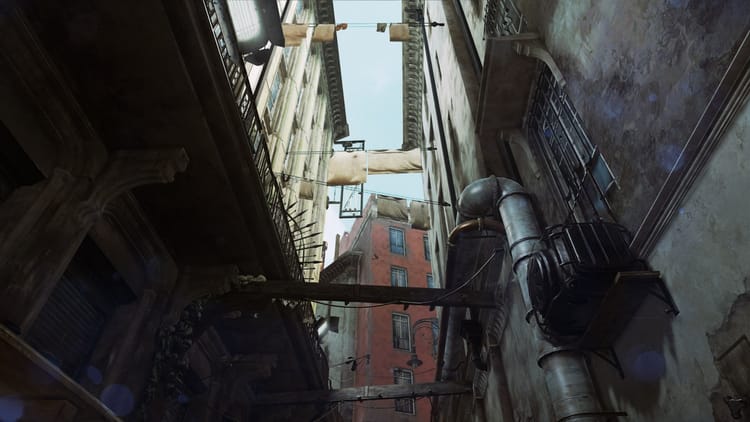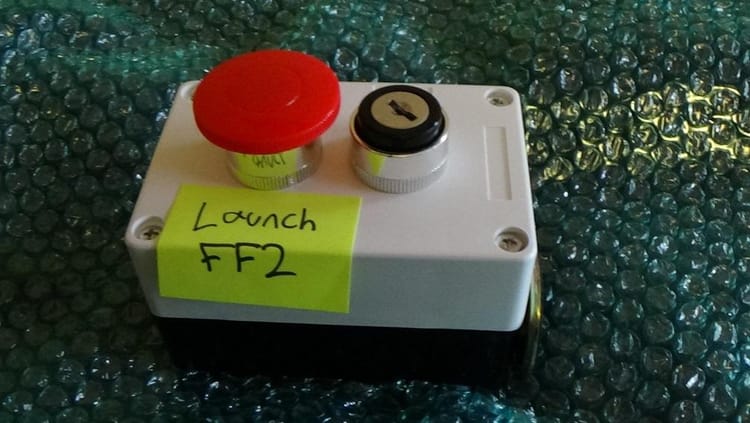Smokestacks and metalwork: The industrial horror of videogames

In the most famous scene in Fritz Lang’s cinematic masterpiece Metropolis (1927), the protagonist, Freder, descends beneath the film’s urban dystopia to find a great network of machinery being tended by nameless, uniformed men. Steam columns, the clouds of this underground microcosm, rise and fall all around as the brass soundtrack mimics the percussive thronging of industrial noise. Freder wanders aimlessly through this metallic maze, looking onwards, terrified, at row upon row of men all operating levers in perfect automated symmetry. As the horns reach their background climax, an eruption of smoke and gas tears through the metalwork and throws men clean from their platforms. The word ‘Moloch!” appears on a title screen, and the film cuts back to a gaping demonic face looking upon the chaos. Slaves and workers are filed through the colossal jaws, as Lang confirms his industrial dystopia as analogous to hell itself.
The precedent set by Metropolis—one that explores industry beyond the confines of the factory floor—endures to this day and manifests itself in nearly every form of media. Videogames, films, and music alike all echo the anxieties of the ‘machine’, and strive to preserve the conscious part of humanity we believe impossible to replace. These fears, however, are not unjust, and artists know this all too well. It seems that as humanity edges ever closer toward the singularity, there are a host of creators, visionaries, and designers beckoning it toward us with a hint of glee on their face.
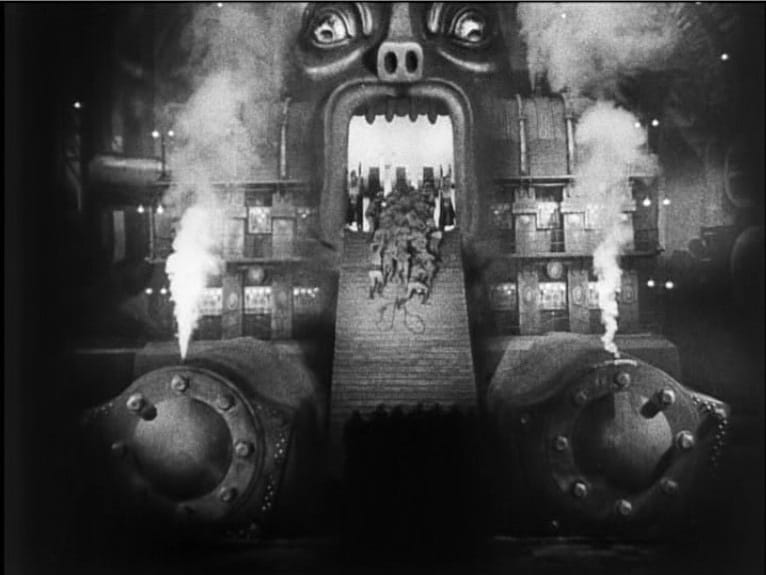
Just what it is that we find so threatening, uncanny, and downright insidious about industrial landscapes and their manifestations is not easily accounted for. It is true that we fear the clinical uniformity of a landscape without soul, depicted in Ghost in the Shell’s (1995) post-cyberpunk iteration of Niihama, where looming pipelines and empty storm drains seem to channel the very essence of life far away from civilization. It is also true that we fear the industrial encroachment on our natural order, a theme touched upon by San Francisco-based studio Campo Santo in Firewatch. The inclusion of a large mesh of wires, antennae, and abandoned comms equipment in the heart of a national park speaks for something far louder than simply a subplot in an already intriguing game. The alien look of the pylons set against a pine backdrop is no mere coincidence: Campo Santo wanted to place at the heart of both the game’s setting and narrative an idea of industry corrupting the romantic image of the American West. The equipment is left unexplained, the anxieties felt in turn by the protagonist and then by us, the player, because Campo Santo wants us to appraise the machinery of modern infrastructure in an environment where it is not so familiar and acceptable.
Inside, the latest puzzle-cum-platformer from Limbo (2010) creators Playdead, takes a more visceral and obvious plunge into the fears only hinted at in Firewatch, and holds up a twisted, broken mirror to a generation now plugged in at the wall.
Hunted and alone, a young boy finds himself drawn into the center of a dark project.
probing into the innate human fear of machinery
This tagline alone hinges on those final two words which, even when separated from the monochrome landscapes captured in the screenshots, sounds distinctively industrial. The word ‘project’ lends the idea of a man-made darkness, a dystopian inversion of the world above ground that Lang had achieved in 1927. Moments from the game see walking lines of distant, automated figures echo the Moloch-ruled hell of Metropolis, and the rainy monochrome conjures to mind the abandoned urban wasteland of David Lynch’s Eraserhead (1977). Playdead are probing into the innate human fear of machinery, of robots, of a world run with cogs and grease rather than conscience and creativity. There is something about the black-and-white static that presents the game as if seen through an old CTR television set, back when they themselves sat in the corner of dark rooms in our houses as small industrial giants in their own right. Controlling a small boy in such an environment leaves us as helpless, alone, and afraid as Freder, as Henry from Eraserhead, and just about anyone who has ever walked an abandoned street at night. They want us to feel alone, they want little color because color is familiar and reminds us of things we have no right to remember. Industry, for Playdead, is an idea and not just a machine. It strips us of control, it clones us, and leaves us rummaging around in the dark for the light switch.
This industrial theme, though, need not be so obviously at play in videogames and film for it to work its subtle horrors. Goldeneye 007 (1997), darling of the first-person shooter genre and multiplayer stalwart, bears its own quiet industrial creepiness. Fan-favorite multiplayer map ‘Complex’ is a winding mesh of walkways, hidden compartments, and air vents. Players stalk empty corridors, hear the footsteps of their unseen assailant, and often fall prey as they blend into the corrugated backdrop. ‘Facility’ borrows the film’s opening factory blueprint for its map design, and hunting each other between the tall silos and across empty factory floors adds a psychological aspect of anxiety and fear to the cult classic. What Goldeneye 007 achieved through its now dated, blocky, nondescript map designs was a strange and uncanny pixel rendering of a familiar industry. Transposed into the basic graphic style allowed for by the Nintendo 64, the spaces become distorted and eerie. The ominous soundtrack with its iconic pipe-ringing sound effect made for an experience entirely unlike the modern FPS multiplayer arenas. You feel more alone on Goldeneye than you could ever possibly feel in today’s big shooters, and that’s because the industrial designs of the game, whether intentional or not, achieved a surreal and uncanny effect.
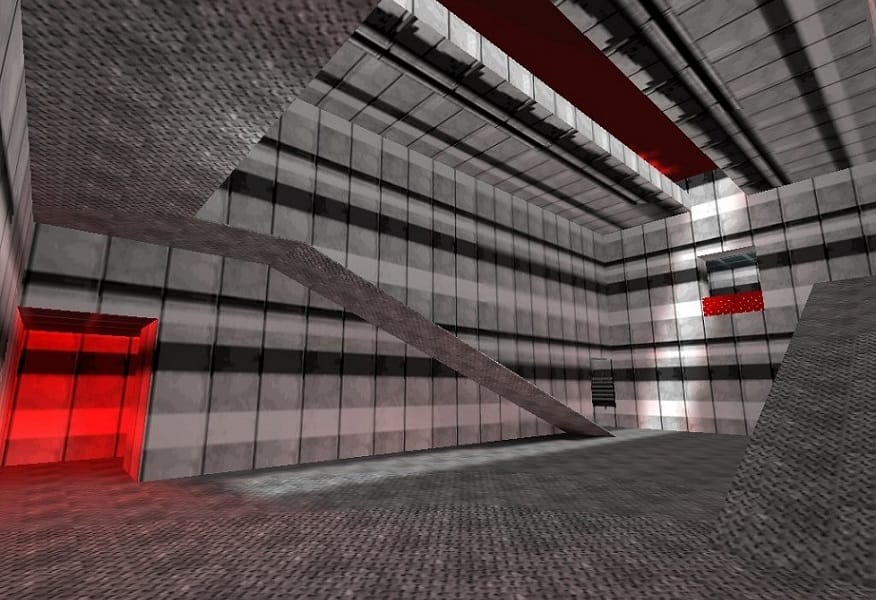
This nuanced evocation of unease and terror was taken in 2015 by Duende Games and turned into an all-consuming meditation on Brutalism and its quasi-industrial rendering of the world around us via their free game Tonight you Die. In the game’s opening, a letter appears on screen and states those three titular words before falling to the ground. Ahead of the character is a fuzzy, static-shrouded graveyard of Brutalist tower blocks and benches, everything asphalt and lifeless. You walk to the sound of a droning soundtrack that rises and falls in random places, interrupted only by the crackling electronic buzz of the various street lamps spilling their monochrome light onto the floor. What is this ‘game’? More importantly, what is the point? A procedurally-generated maze of concrete monoliths and their darkened eaves isn’t what most would readily embrace as a ‘game’, but that’s because it’s not trying to be. A game traditionally suggests some element of lighthearted fun is to be had, but that is admittedly scant in a game that tells you in its opening seconds that you will die that evening.
Duende Games evoke the poverty of Stalinist Russia, the monotony of Metropolis, and the lifeless expanses of Eraserhead in an artwork like no other. It orders you to use headphones, and begs to be played in the dead of night. Industry in this game is less about coiling wires and more about the possibility of nothing beneath the surface. The fizz of lampposts at twilight is as lonely a sound as I’ve heard in a game, and Duende knowingly choose that very noise as the only audible relief in a game of despairing quiet. Why is electricity running in a place where no soul walks save your own? Why do no lights shine on the upper landings of countless towers yet guide you through abandoned courtyards? There is no need for any infrastructure in such a world, and that is where this game’s intriguing horror lies. The slow revelation of isolation is hastened with each doorway crossed, until the player closes down the game and turns on a light and sighs quiet relief.
the possibility of nothing beneath the surface
Innate to the experience of creeping menace in Tonight You Die is its varied ambient soundtrack, sounding part Eno and part Lynch. Music has asked the same questions of our place in an automated, hyperreal world for just as long as videogames and films, and its findings are often even more haunting. Post-rock outfit Godspeed You! Black Emperor’s eschatological debut F♯ A♯ ∞ (1997) begins with an eerie audio narration from an abandoned screenplay, describing a city brought to ruin.
The car’s on fire,
and there’s no driver at the wheel.
And the sewers are all muddied,
with a thousand lonely suicides.
What follows is a description of a city burning bright with the fervor of apocalypse, and an infrastructure brought to ruin. The music evokes a landscape every bit as bleak and lost as those above, but does so through its atmospheric sorrow and elegiac strings. If Mirror’s Edge (2008) showed us a city during the apex of a global infrastructure, then Godspeed shows us that same city when all else has fallen to ruin. I envision the same cityscape from Tonight You Die when listening to this album—it’s nearly impossible not to have been exposed to both. I am alone when I hear it; I am listening to the aural equivalent of Revelations.
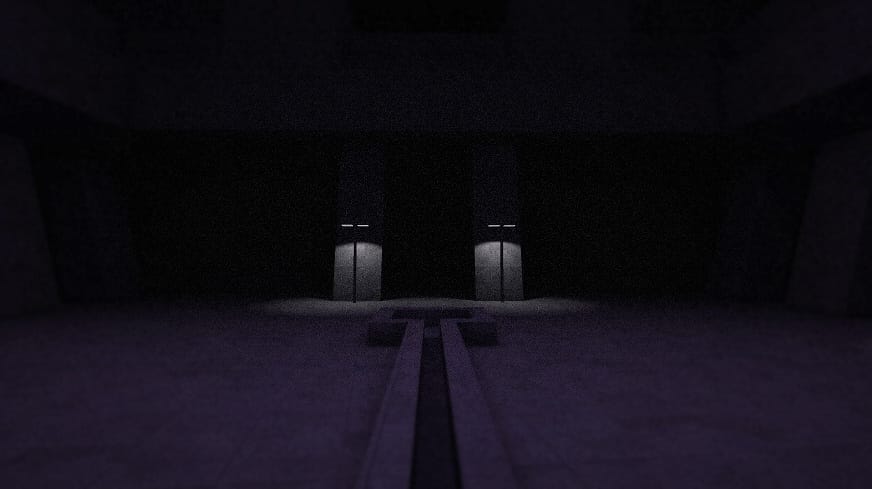
It’s all around us. Everyday. The smokestack on the horizon, the pylon in the backfield, the plug socket in our walls. Everything hums and whines with the flow of our consumer experience, working its volts to and fro like Lang’s enslaved. The above media are only one side of of the proverbial polygon, each adding its own little take on a world run by machines. Studios like Campo Santo, Playdead, and Duendo are not content, however, with sitting by and letting such things slide. They want to show us the ghost in the machine, they want us to be possessed and yet witness the possession. But above all else, they want to warn us.


